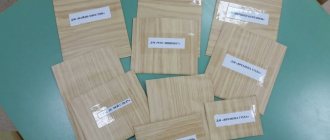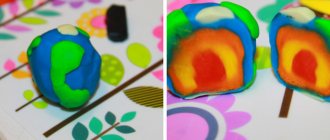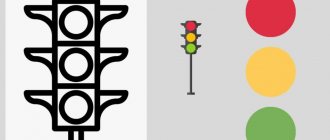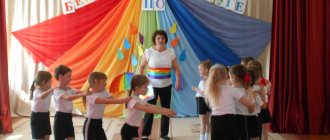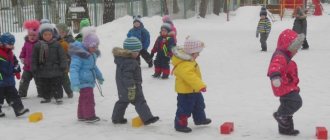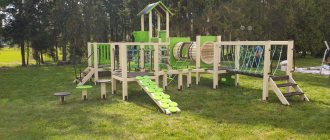Safety games for preschool children
Games for preschoolers that develop knowledge about life safety
Young driver
Before introducing your child to the rules of the road, prepare educational material: cards with images of road signs, a playing field. Ask your child if he knows what drivers should do to ensure that there are fewer accidents on the roads. If the child finds it difficult to answer, use leading questions to lead him to the conclusion: “Follow the traffic rules.” Explain that road signs help all drivers and pedestrians. They indicate where you can cross the road, at what speed the car should go, where you can’t park the car, etc. Signs prohibiting any actions (parking, turning, overtaking, etc.) are usually painted red. And prescriptive signs (indicating the direction of movement, permissible speed), as well as assistant signs (signs for a first-aid post, gas station, service station) are blue. Review the signs depicted on the cards with your child (cards from one group are discussed in one lesson). Place the cards on the playing field in accordance with the direction of the road lane. Ask your child to drive along the drawn road in a small car, following all traffic rules. In the future, increase the number of signs placed and introduce new “vehicles” into the game. Formulate tasks: “Your car has run out of gas, you need to go to a gas station, then change the tires at a service station, and then put the car in the garage.” In this case, the driver must strictly follow the prescribed rules.
Yellow, red, green
Does your child know why there are traffic lights on the roads?
Create a game situation called “Crossroads” by inviting your child’s friends or other family members to the game. Participants in the game “drive” toy cars, the leader regulates the movement by alternately raising yellow, red and green circles. If traffic rules are violated, the driver is issued a fine. When playing, deliberately break the rules of movement, encouraging the child to pay attention to this. Read the poem.
What's happened?
Everyone stood up - the red light came on. And the cars have a free path, Because it’s green for them. We won't go to red, we'll stand and wait. Traffic rules are worthy of respect! Yellow flared up like the sun, Winked at us: “Get ready!” Here's the green light. Hooray! - So it’s time for us to go. (A. Churbanova)
How to cross the road
Create a game situation: roughly depict a roadway by cutting out a wide, long strip of paper. Place cars according to right-hand traffic rules. Ask your child to move the doll across the road. The first version of the game uses a traffic light. The doll stands on the sidewalk and waits for the light to turn green. After that, he checks to see if all the cars have stopped and crosses the road. Invite your child to comment on his actions. Pay special attention to which direction you should look when crossing the roadway (first to the left, then to the right). The second version of the game involves the absence of a traffic light. Consider a sign indicating the crossing location and place it on the impromptu road. What additional symbols can be used to find the transition location? (“zebra” on the road). Lay out the stripes on the playing field. Practice moving different toys across the road.
I took a ride
Make a small hill out of cardboard, and under the mountain there is a paper strip (imitation of a roadway). Roll the ball onto the “road”, moving the slide to different places. In this way, you will demonstrate to your child that an object rolling down a mountain can fly onto the roadway. Encourage your child to voice the conclusion: you cannot sled, ski or bike near the road.
Go around the tram
Make a model of tram tracks by cutting out strips of paper. Launch trams along them. Travel around the city, announcing stops. Invite your child to think about how to get around the tram correctly. Demonstrate clearly that a pedestrian walking around from behind a tram can get hit by the wheels of a tram going in the opposite direction. In the same way, consider the situation of walking around a bus or trolleybus. At the end of the game, summarize the knowledge gained: we go around the tram in front, the bus - behind.
You can not do it this way!
Prepare pictures depicting various emergency situations on the roadway: a child runs across the road, catches up with a ball that has rolled onto the road, a pedestrian crosses to the other side of the street at a red traffic light, a girl on a sled slides onto the roadway, etc. Ask the child to look at the pictures and what exactly should not be done and why. Formulate traffic rules, for example: “You cannot cross the street in the wrong place. You cannot run out onto the roadway. You can’t play next to the road.”
Save the doll
Play out the situation: a child is rolling cars along the road, you have a doll in your hands that runs out onto the roadway unexpectedly for the driver. What threatens the doll? Drivers? How to fix the situation? Guide the doll to the marked crossing. Ask your child to explain the rules of the road to her.
Did not have time!
A child is rolling a car along the road, you are holding a Bunny (toy) who needs to cross to the other side of the street. The bunny knows almost all the rules of the road, so he crosses the road when the traffic light is green. But before he could reach the middle of the roadway, the red light turned on for pedestrians. Play out the situation: the cars are moving, the bunny is running forward (back). Ask your child to explain what might happen to this pedestrian. Draw your child’s attention to the fact that in the middle of the roadway there is usually an “island” outlined in white. Designed specifically for those who did not have time to cross the road when the light was green. Standing in this area, you can calmly wait until the cars stop and continue crossing.
Naughty bunny
Place an inflated balloon in a plastic bag. Bunny came to visit the baby. He says that on the way he found a large package, probably containing a lot of interesting things. The guest invites the child to look into the bag. Interrupt the talkative Bunny and ask the child if it is possible to take and look into packages found on the street. The naughty Bunny, meanwhile, finally got into the bag: the balloon bursts, the Bunny cries. At the same time, take into account the child’s emotional readiness for such effects. If your baby is easily excitable and impressionable, then an oral story about what can happen during such actions will be enough. The bunny repents and recalls several cases “from life”: a familiar bear cub grabbed a bag with a beautiful toy at a bus stop, as a result he is treated in the hospital for burnt paws, etc. Discuss with your baby what to do in such situations (move to a safe distance, call adults, call the police).
Forbidden!
Bunny came to visit the child again. He says that he was in a hurry to get to you and did not even go with the unfamiliar “uncle” to look at the beautiful fish, but he thinks that he will have time to do this after leaving the guests. Scold the stupid bunny and explain to him that you should never go anywhere with strangers, and if they insist on this, you must shout loudly “Help!” Remember the fairy tale “Little Red Riding Hood”, does your guest know what happened to the girl? Invite your child to make a list of forbidden actions for Bunny so that nothing bad happens to the frivolous baby. Listen to the child’s versions and offer your own: - do not talk on the street with strangers; - do not take treats, toys or other items from them; - do not get into the elevator with strangers; - do not pick up empty bottles, cans, or touch bags or packages; — do not approach exposed wires; - do not walk around a construction site, etc.
Do you know?
Invite your child's friends and organize a quiz with questions about fire safety.
Prepare everything you need in advance: cards with questions, chips, posters with relevant topics. The game can be organized according to the principle of transmitting “What? Where? When?”, arranging the questions in a circle and placing a top with an arrow in the center of the table. Children take turns spinning the top and taking the card that the arrow points to. For each correct answer, the player receives a chip. An incorrect answer may result in the loss of one chip. At the end of the game, points are counted and a symbolic prize is awarded, for example, a “Young Firefighter” medal cut out of cardboard. A list of sample quiz questions is provided below.
— Name a profession whose main task is to fight fire. Answer: Firefighter. — What telephone number is used to call the fire brigade? Why? Answer: number 01. It is easy to remember and can be dialed quickly even in the dark. — Why are the fire trucks red? Answer: so that she can be seen from afar and drivers give way to her. — What are firefighter uniforms made of? Answer: from tarpaulin, because it does not burn. — Do you know poems about fire? Answer: S. Marshak “Fire”, “Cat’s House”, “The Story of an Unknown Hero”, K. Chukovsky “Confusion”. — How to put out a fire before firefighters arrive? Answer: fill it with sand, fill it with water, cover it with a blanket, use a fire extinguisher. - What could cause a fire? Answer: due to playing with matches or a lighter, due to unattended electrical appliances, due to a domestic gas leak. — What should you say when calling the fire department? Answer: exact address, last name, first name, telephone number.
Mushroom pickers
Prepare cards with pictures of mushrooms: poisonous and edible. Review them with your child. Draw your child's attention to the external features of poisonous mushrooms - bright or unnatural colors, etc. Tell them what can happen if they are eaten. Place cards with mushrooms on the floor or table, invite your child to go mushroom hunting and collect all the edible mushrooms.
The doll is lost
Create a game situation: you are “walking” down the street and meet a doll that has lost its mother. The girl runs in an unknown direction and cries loudly. Stop the doll, ask where exactly she fell behind her mother, where they were going, whether the baby remembers her first name, last name, mom’s name, dad’s name, home address, phone number. Invite the doll to return to where he and his mother were and wait for her, standing in one place. And so, a frightened mother doll appears and rejoices at meeting her daughter. Talk to your child about what to do in such a situation (stand in the place where you got lost, contact the policeman). Does your baby know his home address, phone number, grandma's address?
First aid
A crying bear cub comes to a child: he fell from a tree and injured his paw. What to do? Invite your child to select everything necessary for first aid. Place cards in front of him with a picture of a bandage, cotton wool, brilliant green, pills, a syringe, a thermometer and ask him to choose what the little bear needs (brilliant, bandage). Let the child play as an ambulance doctor and bandage the victim’s paw. Is it possible to cure an abrasion if there is no bandage at hand? Tell us about the properties of some plants to stop bleeding, read a poem.
Plantain
Along the road, plantains grow here and there.
The poor plantain is all trampled, look. He creeps low at your feet, have pity on him, my friend. A sufferer himself, he is not averse to helping someone else’s misfortune. It can serve well if someone gets hurt. Once you apply the leaf, the wound will heal. (A. Deruzhinsky)
We recommend watching:
Didactic game on traffic rules for preschoolers Interactive game on traffic rules for children 5-7 years old Quest game on life safety in the preparatory group Interactive game on safety “What? Where? When?" in kindergarten in the preparatory group
Similar articles:
Crossword puzzles on traffic rules for preschoolers with answers
Games on traffic rules for children 5-7 years old in kindergarten
Games on traffic rules for older preschoolers
Card index of games on life safety in the middle group
Nina Anatolyevna
Card index of games on life safety in the middle group
At the age of 4–5 years, children strive to imitate the actions of adults in everything, often overestimating their capabilities. In the middle group you should :
continue to get acquainted with the varieties of animals and plants, expand knowledge about possible threats in nature: dangerous insects, poisonous mushrooms and berries, as well as the fact that there are medicinal, beneficial plants that will not cause harm;
continue to study the rules of behavior on the roadway, introduce new road signs and markings, study service modes of transport (ambulance, police, fire, Ministry of Emergency Situations)
;
teach you to monitor your health (introduce personal hygiene items)
;
continue to familiarize yourself with objects and the rules for their safe use (fan, washing machine, fork, knife, electric kettle)
;
teach vigilance when meeting strangers;
develop ideas about the causes of a fire and the rules of behavior when it occurs.
Children in the middle group are actively improving their motor skills. Therefore, it is important to create conditions that will provide children with physical activity. For example, in a group , model a roadway, mark a sidewalk, a pedestrian crossing, a traffic light. Children take turns waiting for the traffic light signal (this can be a green circle raised up by the teacher or any other structure), go to the edge of the sidewalk, look first to the left, then to the right, make sure that no cars are coming and then cross the road. Such actions in the game should create in children the habit of correct behavior. Also at this age, the first social contacts are established. Children love to play in groups of 2-4 people .
Table: fragment of a summary of a didactic game in the middle group
AUTHOR AND TITLE OF THE PROBLEM PRELIMINARY WORK CONTENTS
Ulanova O. N.,
“Let’s introduce Dunno to the rules of the road”
Reinforce traffic rules;
develop social and communication skills;
to form a positive attitude towards road safety rules and awareness of the need to comply with them.
Examination of illustrations on the topic of traffic rules;
solving riddles.
Educator: “Children, let's welcome Dunno! He was in a hurry to meet us, but an unpleasant situation happened to him on the way. Dunno, tell us what happened to you?”
Dunno: “I was walking along a path near the road and playing with a ball, and he took it and rolled onto the road. I immediately ran after him. And I was almost run over by a car, and the driver began to scold me.”
The teacher invites the children to help Dunno and repeat the traffic rules with him.
The children explain to Dunno that playing with a ball near the road is prohibited, but should be done in the yard or on the playground.
Then the teacher invites Dunno to talk about how to cross the road correctly.
Children answer that the road needs to be crossed at the zebra crossing.
and at a green traffic light.
Dunno thanks the guys for helping him a lot and promises not to break any more traffic rules. Children and Dunno dance to the music.
Outdoor games of traffic rules and life safety.
Game index
according to life safety and traffic rules
Game “LISTEN TO THE SIGNAL
Goal: develop dexterity, stimulate attention.
Equipment: two arches, two benches, two fences, a ladder.
Game actions: at the leader’s signal, the first player from one team puts on a helmet, walks through the obstacle course, returns, and passes the helmet to the next player. The team that completes the task faster wins.
Game "FIRE HOSE".
Goal: stimulate reaction speed, dexterity.
Equipment: two fire hoses.
Game actions: children are divided into two teams and, at a signal, first unroll the hoses, then roll them back to their original state. The team that completed the task faster wins.
"RESCUE CALL"
Word game
Goal: stimulate the development of coherent speech.
Game rules: compose a short story according to the plan (sample): correctly and clearly state your name, surname, location, briefly describe the problem.
Game actions: compose a short story as the slides appear on behalf of one of the heroes of the situation or an outside observer.
Frames change on the PC screen, children talk into a toy phone about the situation.
"SAVE THE TOY"
Didactic game
Goal: develop the ability to recognize familiar objects through glasses; stimulate the development of visual perception; develop the ability to correlate a schematic image with an object.
Game rules: find, remember and select the ones you need from a set of pictures.
Game actions: look at images of familiar objects through the “smoke” (curtain), remember them, then select the ones you need from a set of pictures.
Next task: sometimes rescuers have to work in special equipment - for example, safety glasses. Wear special glasses. Everyone will receive a card with a schematic image of a toy, according to which they need to find and save the toy in a “smoky room.”
"RESCUERS"
Didactic game
Goal: to develop the ability to correlate a schematic image with a natural object; stimulate the development of visual perception.
Game rules: find an object based on its schematic image.
Game actions: look at the schematic image, find the corresponding toy in the play area.
"FIND AN OBJECT"
Didactic game
Goal: to develop the ability to recognize familiar objects from images; stimulate the development of visual perception and memory.
Game actions: look at images of familiar objects through a “noisy” file, recognize and name the objects.
Game rules: name the object you recognize in the picture, explain how you recognized it.
Q. Imagine that we are on a fire tower. Using binoculars, try to identify objects below that are in the smoke and fire.
Well done guys, and well done Carlson! Next training task: I will name the words, and you listen carefully. If you hear the name of an item that could cause a fire, say “oops.”
“FIRE HAZARDOUS
OBJECTS”
Didactic game
Goal: stimulate the development of reaction speed and attention.
Game actions: name objects in order, clap your hands.
Game rules: learn words denoting fire hazardous objects.
A set of words for the game: iron, magazine, TV, pen, toaster, chewing gum, cracker, diaper, pacifier, cutlet, compote, fireman, cake, cuts, fire extinguisher, bag, brush, helmet, sleeve, notes, paint, matches, bandage , drill, mask, etc.
"FLASHLIGHT BEAM"
Didactic game
Goal: to develop the ability to recognize images by their parts, details.
Game actions: examine the details of the image, recognize and name the object.
Game rules: quickly recognize an object by the details of the image.
"FIRE ALARM"
Relay game
Goal: to develop coordination, reaction speed, and the ability to quickly navigate in space.
Game rules: complete the task one by one, take only one piece of fabric (fire).
Game actions: players are divided into two teams, line up in columns; Using “stilts”, children take turns collecting pieces of red fabric scattered around the hall, symbolizing fire, putting them in a bucket (located on the opposite side of the hall from the teams).
"PUT OUT THE FIRE"
Relay game
Goal: develop speed, agility; develop the ability to work in a team.
Game rules: try not to spill water, act on the signal.
Game actions: teams stand in a line facing each other, near the last participants there are 4-5 plastic buckets of water; at the signal, the last player passes the buckets one by one to the children (one after the other) standing to his right (left); the first player pours the buckets into a large bucket “with fire” (with collected pieces of fabric) - “put out the fire.”
"RESCUING A TOY"
Relay game
Goal: to improve in a competitive form the skills of basic types of movements (walking on an inclined board, climbing a gymnastic wall); develop speed-strength abilities, agility; cultivate courage and the desire to come to the aid of the “victim.”
Game rules: complete the task one by one, do not drop the toy.
Game actions: using a rope, climb an inclined board to the upper slats of the gymnastic wall; take the toy located on the top crossbar; with an additional step, move to the adjacent span of the gymnastic wall; go down the gymnastics board (“roll down the slide”); move the toy to a safe place.
"ASSEMBLE A BACKPACK FOR A RESCUE"
Relay game
Goal: develop coordination abilities, dexterity; build confidence in your actions; stimulate intelligence, speed of reaction, consolidate knowledge about the purpose of the presented objects.
Game rules: ride the exercise bikes strictly in a straight line, select only the necessary items.
Game actions: players are divided into two teams; ride the exercise bike one by one to the opposite side; select items laid out on the bench that may be useful to rescuers; go back, put the item in the backpack.
"RISK TERRITORY"
(Gym)
Medley relay
Goal: develop strength, agility, coordination of movements.
Game rules: overcome obstacles one by one.
Game actions: climb the stairs of the sports complex; Grasping the crossbar of the sports complex with your hands, without touching the floor with your feet, move to the opposite edge; go down the pole to the bench; walk along it, stepping over objects; overcome the tunnel and dry pool. The phone rings (alarm signal).
B. The assistant teacher in the younger group discovered many objects that were dangerous for the kids. Help is needed! Children come to the group.
Q. Our task?
Children. Find and neutralize.
B. In order to find objects, everyone receives a diagram card that shows where to look for the object (on, under, behind, in). Found items are placed into boxes according to the type of danger (stabbing, cutting, flammable, etc.).
"FIND AND DISHARM"
Didactic game
Goal: develop the ability to navigate in space; exercise children in correlating the image of the location of an object with a symbol; develop the ability to classify objects according to different types of danger.
Game actions: searching for objects in different places, putting them into appropriate boxes.
Game rules: find the toy according to the symbol.
Q. Where could they have come from? Maybe strangers came to our garden? What should we do now with these items? (We'll take it with us to give it away)
"STRANGER"
Training game
Goal: to exercise the ability to behave correctly in situations with a stranger, to form a model of behavior in such situations.
Game actions: children teach Carlson how to behave in a situation with a stranger.
Stranger. Hello guys. How wonderful you are! Help yourself to some sweets.
Carlson is the first to help himself. The children take (do not take) the treat. If someone takes candy (tangerines), the teacher asks the children if they did the right thing.
Stranger. I still have a lot of tasty things in my car! There is also a cat and interesting toys... Come with me!
Carlson is going to go with the Stranger.
Q. Is Carlson doing the right thing? (Addressing a stranger.) Who are you? Who have you come to?
Stranger (does not answer, grabs Carlson by the hand and pulls him towards the exit). I see you are good! Do not listen to them! I'll take you to your mom, she asked me to pick you up!
Carlson cries and obediently follows the Stranger.
Q. Guys, what should you do if a stranger drags you along? (Break out, scream loudly, call for help.) Woman, leave Carlson alone! (Pushes the Stranger away, takes Carlson’s hand.) We have a manager, go to her.
The children see the Stranger off and give them boxes with dangerous objects. Carlson's phone rings.
Carlson. Baby is calling me! Hello! Where are you? Guys, he's lost! Baby, tell me where are you?
Baby (on speaker phone). I'm lost. Playing with friends...
Carlson. Where can I find you?
Baby. My photos will help you. I will transmit them over the Internet.
Q. We haven't received any email?
V. Yes, I just arrived. Receive your message.
Q. Guys, we received photographs that will help us find the Kid. The Kid took photographs of objects encountered on his way, places where he played: a sandbox, a tree, a flower bed, a broom, a first aid station, etc. Using these landmarks, the children find the Kid, explain to him in which places he should not play, and invite him to the service "Young Rescuer"
“HOW TO AVOID TROUBLES?”
Didactic game
Goal: to develop the ability to classify and explain dangerous and safe situations depicted in the pictures.
Game actions: briefly explain the plot of the picture, its consequences.
Game rules: briefly and clearly describe the plot picture in accordance with its image.
"DANGER - NOT DANGEROUS"
Goal: to teach children to distinguish dangerous life situations from non-dangerous ones; be able to foresee the result of a possible development of the situation; consolidate knowledge of the rules of safe behavior; cultivate a sense of mutual assistance.
Equipment: a set of didactic pictures depicting situations that are dangerous and non-hazardous to life and health; cards of different colors (red, white and yellow) depending on the game options. Contents of the pictures: a child climbing stairs, reading a book, jumping from a height, dressed inappropriately for the weather, coughing on others, etc.
Children are asked to determine the degree of threat of the proposed (visual or verbal) situation to life and health, pick up a certain card, depending on the danger, and correctly arrange didactic pictures.
After carefully listening to the teacher’s story, the children raise a red card if there is danger, yellow if danger may arise from certain behavior, and white if there is no danger. Children should not interfere with each other, if necessary, supplement the answers of their comrades, not give hints or use hints.
"IF I DO THIS"
Goal: to draw children’s attention to the fact that in every situation there can be two ways out: one is dangerous to health, the other is not threatening; cultivate a caring attitude towards yourself and other people, protect others, and not cause pain; develop thinking and intelligence.
Equipment: a set of incentive items: chips, stars.
Children are given the task to find two ways out of the proposed situation (threatening and non-threatening to life and health) or to offer two options for the development of this situation. After listening to the teacher’s story, the children continue it after the words: “Danger arises if I do...”, or “There will be no danger if I do...” Children raise a red card if there is danger, yellow - if danger may arise from certain behavior, white - if there is no danger. Children need to listen
comrade's answers, do not interrupt each other, express the desire to answer by raising your hand. Complete answers and significant additions are rewarded with a chip or an asterisk.
"AMBULANCE"
Goal: to consolidate children's knowledge and practical skills in first aid.
Equipment: pictures depicting medical supplies (thermometer, bandage, brilliant green).
The teacher plays out with the children the situation when a person cut his arm, leg, broke his knee, elbow, then got a fever, a sore throat, a speck of dirt got into his eye, and his nose began to bleed. For each situation, a sequence of actions is worked out.
OUR ASSISTANTS - PLANTS
Goal: to strengthen children's ideas about how to help themselves and others always stay healthy.
Equipment: subject pictures depicting medicinal plants.
The game is played on the lotto principle. Children have cards with images of medicinal plants. The teacher shows pictures with similar drawings. A child who has this plant talks about its use for healing. If he said it correctly, he gets a picture. The one who closes his card first wins.
"JOURNEY TO THE COUNTRY OF HEALTH"
Goal: to strengthen children's ideas about how to help themselves and others always stay healthy.
Equipment: playing field with pasted illustrations; cube, colored chips or buttons.
The players take turns throwing a die, on the sides of which there are 1 to 3 circles depicted, and move their chip forward as many moves as the circles appear on the die. If the chip is on the red circle, then the child, before making the next move, must answer how to behave with a runny nose, cough, high temperature, or toothache. If the answer is incorrect, the child skips a move, but if the answer is correct, he makes the next move. When the chip ends up on the green circle, the player tells how movement, daily routine, vitamins, and water procedures are beneficial for a person. If the answer is incorrect, the child skips a move; if the answer is correct, the child moves the chip forward three moves. The first one to reach the land of health wins.
My choice
Children are offered story pictures and corresponding texts for them. The teacher reads out the text, and the children prove the correctness or inadmissibility of this action and explain what rules were violated. If the child explains the action correctly, he receives a red chip; if not, he receives a blue chip.
OUR STREET OR TRAFFIC LIGHT
Objectives: to consolidate children's knowledge about traffic lights, concepts: street, road, sidewalk, trees, houses; remember the traffic rules.
Children are taught not to rush when crossing the road, to be attentive, to know and find the place of a pedestrian crossing, to understand traffic lights and road signs.
"BUS"
Goal: consolidate knowledge of traffic rules; practice proper communication skills, speech, social behavior.
Equipment: small chairs; steering wheel.
Using a counting rhyme, a driver is selected. Modeling situations: a woman with a child, a grandmother, a blind man.
Transition
Reinforcement of traffic regulations. There are stripes on the floor marking the crossing, and the traffic light is red. Children are standing at the crossing. The traffic light is yellow. When the signal turns green, children walk along the crossing, first looking left, then right.
"TRAFFIC LIGHT"
Didactic game
Goal: to familiarize children with traffic signals, to consolidate knowledge of the rules of driving according to traffic signals.
Children and an adult examine the traffic light, fix the meaning of the colors. Then the adult invites one of the children to take on the role of a traffic light and put on a “traffic light” badge. The rest of the Children represent cars and pedestrians who must move according to traffic lights.
"ROAD SIGNS"
Didactic game
Goal: to familiarize children with prohibitive, prescriptive and some warning signs.
Game options
“Different among the common” Children are asked to sort the signs into groups and tell what they mean.
“We play ourselves” Children are offered cards with different road situations. The guys must choose the right road signs for the pictures, then justify their choice.
“City Street” Children are invited to act as traffic police inspectors in a new city, where they need to place road signs to avoid traffic accidents.
“SO THAT NO TROUBLES HAPPEN”
Didactic game
Goal: to familiarize children with the rules of behavior on the street and on the road; consolidate knowledge about road signs.
Children are offered a model of a street with various types of signs and traffic lights, toys for role-playing situations (crossing the street, driving a car, walking around the city, cycling).
"CROSSROADS"
Didactic game
Goal: to familiarize children with such a place on the street as an intersection, with the rules of crossing at an intersection (regulated and unregulated); consolidate knowledge of road signs.
Children are presented with a mock-up of an intersection with various signs and a traffic light. An adult explains how to cross the street at a controlled and unregulated intersection.
